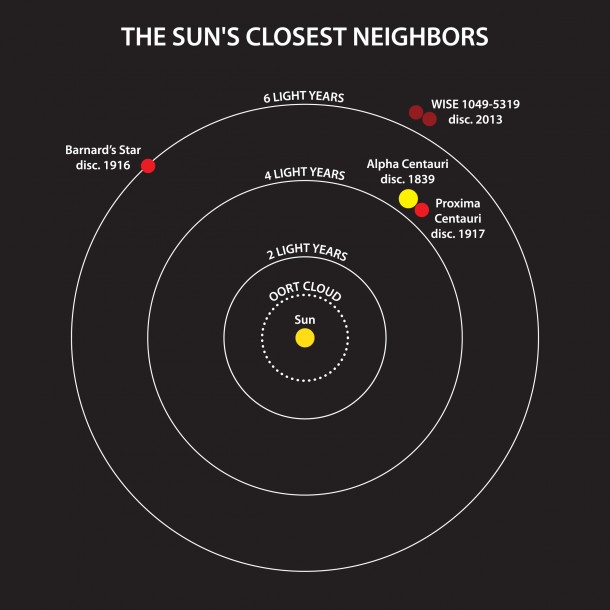Barnard's Star
| DISTANCE 5.97 light years |
| MASS 0.144 |
| LUMINOSITY 0.00044 |
| RADIUS 0.196 |
| SURFACE TEMPERATURE 3134 K |
| AGE 11 to 12 billion years old |

Named after the American astronomer Edward Emerson Bernard who discovered it in 1916, and with an estimated age of 11 to 12 billion years, this very low-mass red dwarf 'flare-type' star of spectral type M5 is considered very old even by most red dwarf standards. Just to add to its "old age" peculiarity, Barnard's Star is moving, relative to our Sun, at about 140 kilometres per second, making it the fastest moving stellar object known to us. At this speed, it will make its closest approach to us at a distance of 3.85 light years in just under 10,000 years time.
Measurements of its path through space did create a lot of excitement among astronomers at the Sproul Observatory, Pennsylvannia, USA, since the work began in the 1940s. According to Peter van de Kamp and his colleagues at the observatory, the data suggested the presence of two large planets in orbit due to a slight wobble in the star's motion through space. Further analysis using data from other, more modern observatories has placed de Kamp's observations of possible dark companions in doubt, but not totally discounting the idea.
Only a direct visit to the star will solve the planetary debate once and for all. But if the debate is more to do with finding out if alien life exists in the universe, there are far better star systems we could visit out there.
In fact, due to the reasonable prospect of finding planets, Barnard's Star had been the target of possible future exploration through an unmanned spaceship known as Daedalus — a nuclear-powered machine devised on paper by the British Interplanetary team in 1973. While Barnard's Star still remains of great interest to astronomers, when a spaceship is finally built to travel to the stars (mainly of the electromagnetic variety, which is easier to build, travels faster, and could be built in the next 10 to 15 years), it is likely the search for planets and alien life will take place with those stars closer to our Sun. Even if scientists are itching for an opportunity to see a red dwarf, they would do well to visit Proxima Centauri — the red dwarf closest to our Sun.


Luhman 16 (WISE 1049-5319)
| DISTANCE 6.5 light years |
| MASS A: 0.032 B: 0.027 |
| LUMINOSITY A: 0.0000219 B: 0.0000209 |
| RADIUS A: 0.87 B: 0.107 |
| TEMPERATURE A: 1,350 K B: 1,210 K |


WISE 1049-5319, also known as Luhman 16, is a binary brown-dwarf system located in the southern constellation Vela. Emitting so little light and looking rather uninspiring in the night sky that for a long time astronomers never realised this binary system existed and was a close neighbour to our Sun. Then, in March 2013, after using NASA's Wide-field Infrared Survey Explorer (WISE), astronomer Professor Kevin Luhman of Penn State University and his colleagues obtained enough data and careful analysis of multi-epoch astrometry to convince him that we now have two brown dwarfs sitting close by to our Sun. The dwarfs are said to be orbiting each other every 27.54 years in a moderately elliptical form, with an eccentricity of 0.343. The average separation between the stars is approximately 3.557 astronomical units (AU).
For readers who may not be totally familiar with what these objects are, a brown dwarf is strictly speaking not a star. It is more closely akin to a gaseous planet like Jupiter only much larger and hotter, but not quite large enough and hence hot enough to initiate nuclear fusion reaction to become a star. In the case of this brown dwarf system, these oversized planets do emit a reasonable amount of heat, but not quite enough visible light to stand out in the night sky to the point of saying, "Hey, look at me. I'm interesting!".
Our latest newcomer has created some interest among scientists. In particular, Kevin Luhman, a Pennsylvannia State University astronomer and a researcher in Penn State's Center for Exoplanets and Habitable Worlds, said:
"The distance to this brown dwarf pair is 6.5 light years — so close that Earth's television transmissions from 2006 are now arriving there.
It will be an excellent hunting ground for planets because it is very close to Earth, which makes it a lot easier to see any planets orbiting either of the brown dwarfs. It might one day be one of the first destinations for manned expeditions outside our solar system."
If Luhman is eluding to us of the possibility of life around this binary system and wants to send probes to find out, he might find it a little easier, quicker and more probable to find what he wants at Alpha Centauri and in a more advanced state than any scientist could ever have imagined. Even the map below as prepared by Janella Williams of Pennsylvannia State University shows it would be much easier to go to Alpha Centauri first before mucking around at a further distance just to get to this binary system (and be potentially disappointed with the lack of life over there):

Maybe we shouldn't make things more difficult for ourselves than is necessary. If searching for alien life is meant to be the ultimate goal in visiting other star systems, you might as well just visit another sun-like star and be done with it. And with Apha Centauri being closer to our Sun, you can be sure where the punters will put their money on in finding alien life.
But, then again, if there is a chance alien microbes might exist and be growing on a neighbouring planet (or satellite) around one of both of these brown dwarfs, you can be sure NASA will do all it can to send probes to this system. It was only in the 1970s when scientists were thinking of sending a nuclear-powered spaceship called Daedalus to Barnard's Star to perform a typical fly-by mission just to tell us if exo-planets existed around this star. Now we are considering going for another second-rate star system to find alien microbes. Seriously, how about going for an advanced alien civilisation with a technology at a first-rate star system like Alpha Centauri and stop for a visit using the right technology? So much better surely!
At any rate, the discovery has at least given greater hope to the NASA-funded WISE project of finding more planets beyond our solar system.
Further details of Luhman's discovery can be read from his scientific paper. If you have trouble finding his paper by any chance, we recommend trying here.
WOLF 359
| DISTANCE 7.78 light years |
| MASS 0.11 |
| LUMINOSITY 0.00002 |
| RADIUS 0.144 |
| TEMPERATURE 2,749 K |

Wolf 359 is a red dwarf star located in the constellation Leo, near the ecliptic plane of our solar system. A red dwarf star (spectral type M8) is about 20 billion years old, emitting bursts of light through flares and even radio noises. It also seems to emit extra strong x-rays and gamma rays just to keep any alien life form on an unseen planet well underground for protection. The star also has a strong magnetic field to boot.
So far, no official planets have been detected at the present time.
Lalande 21185
| DISTANCE 8.29 light years |
| MASS 0.46 |
| LUMINOSITY 0.0052 |
| RADIUS 0.39 |
| SURFACE TEMPERATURE 3,601 K |
| AGE 7.5 billion years |

Lalande 21185 (named after the French astronomer Jérôme Lalande who published its celestial coordinates in 1801) comes in a variety of scientific names, such as BD+36 2147, Gliese 411, and HD 95735. No matter how many names we give it, scientists know with reasonable confidence that this is a red dwarf star located in the constellation Ursa Major. Although it is a variable 'flare-type' star emitting bursts of light, a large dark companion of mass 20 relative to Jupiter with an orbital period of 420 days and an orbital distance of some 10.5 million kilometres seems to be present — it is probably a brown dwarf (i.e. this may be more a star than a planet). Lalande 21185 (spectral type M2) is about 20 billion years old.
However, in more recent times, observations are indicating that as many as three planets may be circling the red dwarf. Two of them are certain, whereas the third planet remains tentative at the present time. Over the years, astronomers will learn more and make a more definitive announcement on the likelihood of this third planet being present.
Apart from those details, we know the star is heading in our direction. In about 19,900 years, it will be at its closest distance to the Sun, approximately 4.65 light-years away. Certainly by then we will have the electromagnetic vehicles to venture to this star system without too much trouble.